Menu
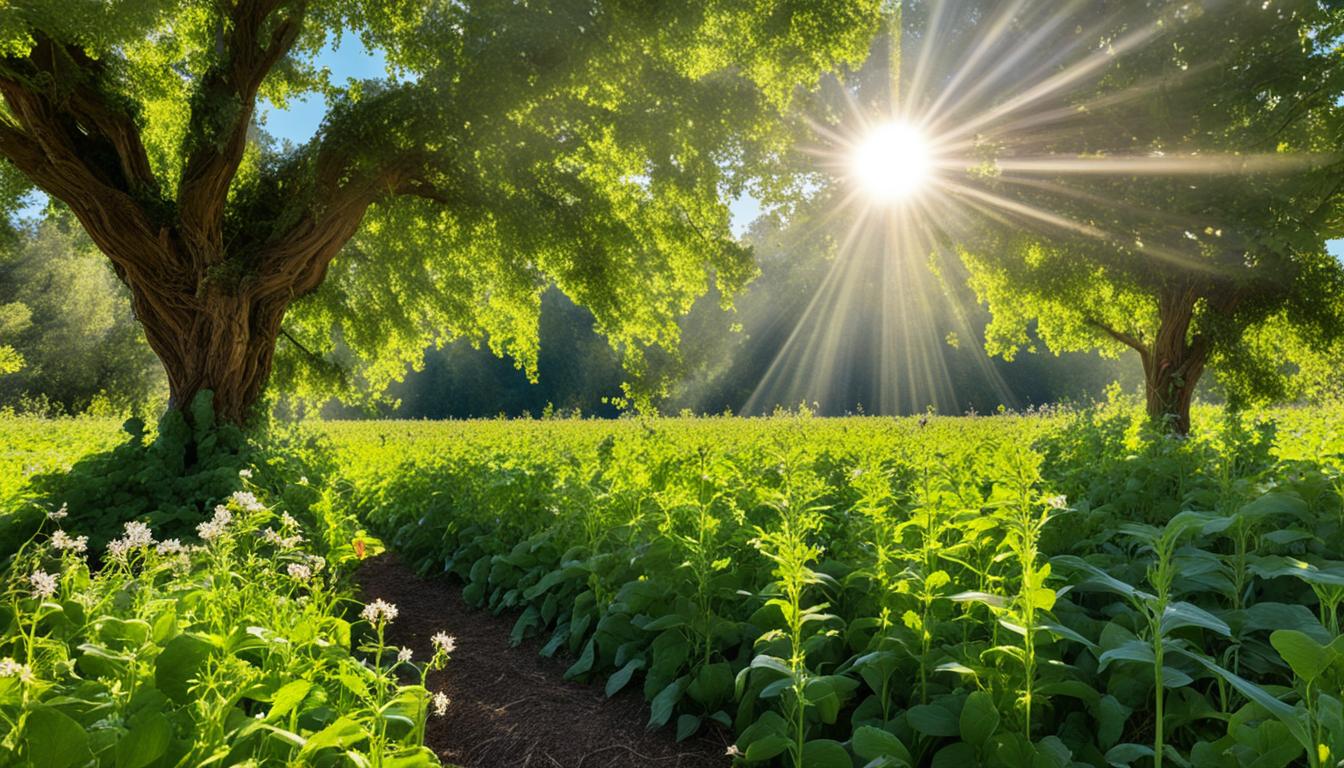
Think about a beautiful forest filled with life. When I do, I realise how much we need nature. Walking through areas with trees, crops, and animals feels magical. Agroforestry brings these elements together. It’s a light of hope when the world’s nature is in danger from many things like too many people, too much stuff, and the changing climate.
Many plants and animals in Europe need farm-like places to live. It’s great that agroforestry helps. Mixing farming with tree growing boosts life quality by a ton. Studies show it’s much better for plants and animals than just having forests. Sadly, when we turn these mixed farms into single crop fields, we lose a lot of living things.
Agroforestry does more than keep species alive. It also makes homes for them that are safe and rich. This way of using land is not just old; it’s super important today. By planting trees and crops together, we get both good food and we don’t harm our environment much. It fits well with big plans like the United Nations’ and the European Union’s to protect Earth’s homes and the living things in them.
In recent years, the agroforestry significance has become very important. It helps deal with the fast changes in global biodiversity. Studies show that in Europe, about half of all plant and animal species need farms to survive. This shows it’s crucial to include agri-environmental measures in farming to protect these ecosystems.
Agroforestry mixes farming and forestry methods. It hosts 50–80% of the diversity we see in forests naturally. This not only saves biodiversity but also improves our environment by controlling erosion, water and air quality, and helping with important processes like pollination and managing pests.
The cultural benefits of agroforestry are huge. It improves soil, makes landscapes prettier, and helps store carbon. The Common Agricultural Policy (CAP) in Europe has made some places more about production, which has hurt less productive areas. Yet, using agroforestry offers a way to keep agriculture sustainable without its major downsides.
Many studies point out the help agroforestry gives to biodiversity. They show that it has a 60% higher variety of species than regular forests.
This type of farming also helps protect animals and plants in danger. The Mediterranean, for example, has lost a lot of its biodiversity. Here, agroforestry plays a big role in conservation. The efforts to use agri-environmental measures meet goals set for 2030, helping agriculture be both sustainable and resilient.
| Aspect | Agroforestry Benefits |
|---|---|
| Biodiversity Preservation | 50-80% diversity of natural forests |
| Species Richness | 60% greater mean richness |
| Ecological Services | Improves erosion control, water quality, soil health, air quality, pollination, pest control |
| Publications Increase | From 33 (1991-2000) to over 110 after 2000 |
| Cultural Impact | Enhances landscape beauty, supports cultural heritage |
The evidence strongly supports the value of agroforestry in our farming systems. It boosts cultural farming benefits and helps reach sustainable development goals. By combining food production with ecosystem support, agroforestry is a key strategy to enhance biodiversity and protect nature for the future.
Agroforestry is a key practice that combines trees with crops or livestock. It boosts *ecosystem services* and enriches soil quality. By supporting a variety of life, it helps to protect our planet’s biodiversity. In Europe, the focus on certain types of farming has left some places unchecked, which isn’t good for local wildlife.
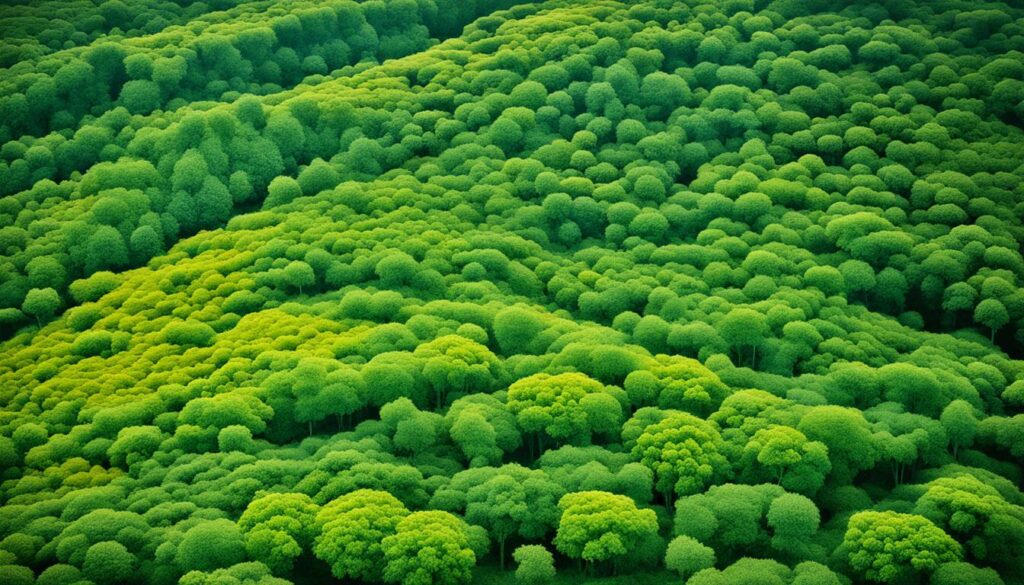
Research shows that agroforestry makes areas more complex and varied. This helps many different species to thrive. The idea known as the Habitat Amount Hypothesis suggests that more varied habitats mean more types of plants and animals can live there.
Compared to forests, agroforestry has been found to have more of these living things. This is because it offers a wide range of living spaces and connects different areas, creating a strong ecological web.
Agroforestry supports the aims of the European Union for 2030. It helps provide natural services, control features, and adds to food production. Virtual studies back up the important role agroforestry has in boosting biodiversity in farming areas.
Traditional farming, such as growing a single crop, has hurt wildlife. Problems like this are fought by agroforestry, which uses the land in more balanced ways. This kind of farming not only supports more living species but also makes the soil healthier.
There’s been a big rise in interest in agroforestry. This is shown by the many views on articles discussing its benefits. Using agroforestry in farming is key to keep our planet’s ecosystems healthy over the long term.
Agroforestry plays a key role in making farms stronger against challenges. It combines trees and crops in a way that helps soil and nutrient life. This mixture also fights soil erosion well.
Agroforestry boosts soil health by adding more organic matter. Trees’ roots create a path for better air and water into the soil. This invites a wider variety of plants and animals into the ground. Such a rich soil environment can keep 80% of the biodiversity well-natural forests do.
This diversity is a big plus. It keeps the soil strong and ready for plants to grow. In turn, this helps the whole farm stay healthy and protected against problems.
Agroforestry is great at fighting soil erosion too. Its mix of plants, including those with deep roots, holds the soil tight. This prevents it from being washed or blown away.
Research by Bhagwat et al. has shown that these farms have more life forms than regular forests do. It’s thanks to many different kinds of plants working together. This teamwork acts like a shield, keeping the soil from breaking down.
Agroforestry also stands out in keeping nutrients in the farm. Trees and crops working side by side make sure nutrients don’t run off or wash away. Most studies, about 75%, agree on the positive effects of this farming method. It says this helps farms stay productive and safe for the environment.
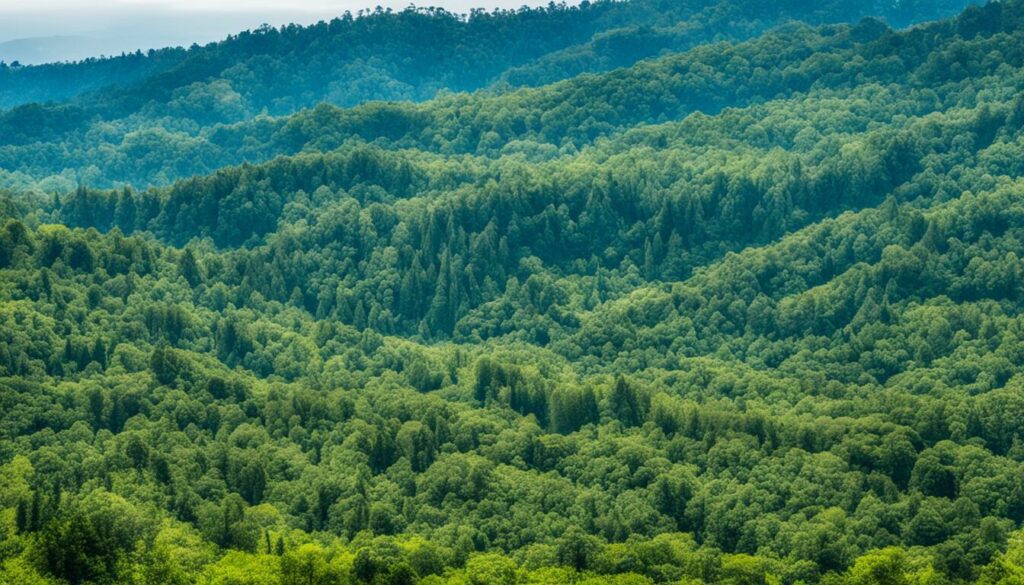
Agroforestry changes farming by mixing trees and crops, unlike just growing one thing. This method has big wins for the land, not just economically. By combining different plants, it helps keep more life in the soil, making farms more productive.
It’s not just about the soil. Agroforestry also makes the ground healthier by keeping it from washing away, letting water in better, and upping the stuff like leaves and roots in the dirt. Plus, trees hold onto harmful carbon from the air, lowering their levels and fighting climate change.
Agroforestry is a hit because it keeps life diverse. By mixing trees with other plants, it invites more birds, bugs, and useful critters. This leads to less pests and better pollen spread by these creatures. Plus, trees help save water, cutting down how much you need to hose your crops.
For farmers, doing agroforestry means more money from different types of plants and animals, not just one. It makes things more stable financially and kinder to the land. Plus, more plants together mean they help each other grow better, making the farm stronger.
Taking the agroforestry route makes the environment stronger too. Rotating crops and planting many kinds together help the whole system work better. This is proven to outdo farms that just grow one thing, making a healthier planet and stronger farms.
Choosing to do agroforestry is also about helping communities thrive. It gives jobs, makes communities more able to bounce back from hard times, and spread the wealth in different ways. This kind of farming is good for making more food without hurting the land. It supports both nature and local economies.
To wrap it up, agroforestry offers a full-on farming method that’s both green and profitable. By going this route, farmers get to boost their harvests in a way that is good for the Earth. It’s all about farming smarter, not harder, to keep the planet and people happy for the long term.
Agroforestry is key to saving various species and making sure habitats connect. This is crucial for strong ecological networks. It adds both structure and function to farm areas by mixing trees and crops. This mix makes a better home for a wide range of wildlife.
The Mediterranean area is well-known for its many species, but these are under threat. Agroforestry helps keep important plants safe, aiding in saving different species. It mixes many plants together, protecting their genes. This helps the natural world cope with change and stay diverse.
Agroforestry makes pathways for wildlife to move easily. These paths are crucial for the travel of birds and insects. They prevent inbreeding and keep populations strong. The idea fits with the Habitat Amount Hypothesis. This theory shows having more types of homes available helps more species live together well.
The European Common Agricultural Policy was not good for every region. It pushed farms to specialise, which hurt many natural areas. Agroforestry helps slow down this damage. It does so by keeping local nature in balance. With many different plants and trees around, farms support lots of wildlife.
| Regions | Agroforestry Impact | Statistics |
|---|---|---|
| Mediterranean | Species Preservation | High species loss in agroecosystems addressed by agroforestry. |
| Virtual Landscapes | Biodiversity Modelling | Simulations showed higher species richness in tree-dominated patches. |
| Brittany | Hedgerow Planting | 20% of farmers plant hedgerows, with 70% using the produced wood. |
Agroforestry mixes farming and forestry to help nature. It makes ecosystems richer and keeps the land strong. This way, farming and wild places live well together. Studies show agroforestry has more kinds of plants and animals than just forests. This makes it key for saving different life forms.

Agroforestry is great at keeping around half to four fifths of a forest’s life. This info is vital for planning how lands should look. Making agroforestry fields just into one type of plant can lower life variety. That’s why it’s important to keep agroforestry mixes varied, like having different types of trees in rows. Over half of studies on plant variety show this is true.
This method doesn’t just keep nature rich but also stops places from being fully changed. By mixing trees and crops, agroforestry stops lands from turning into just farmland. It keeps lands both useful for food and good for nature. For example, farming edible plants this way in North America shows how well it works.
Agroforestry also helps make paths for animals and plants to move, like riverside woods in the Appalachian mountains. These places can change a lot in just a few years. Also, farming with trees and grasses together is popular in the USA and Canada. It shows how different places can use this mix of trees and crops.
Good ways of planning land with agroforestry are key for saving more kinds of life by 2030, like in Europe. But sometimes it’s hard to guess how well agroforestry will work for keeping life rich. To fix this, a new idea says the more variety in an area, the more life it can have.
Some projects in Southern Europe are using computer models to see how planning affects life. This helps tell which lands help more, whether they are full of trees or crops. It shows more about how farming and nature can work together.
| Agroforestry Practices | Key Findings |
|---|---|
| Alley Cropping | 55% dominance of Juglans and Populus |
| Forest Farming | Supports fruits, nuts, berries, greens, mushrooms, and wild vegetables |
| Silvopasture | Combines hardwood and evergreen trees with various grasses |
| Riparian Buffers | Seen variations in species density over a four-year study |
Altogether, agroforestry is a smart way to help nature and plan the land. By mixing trees with crops, it helps farming be good for the earth. This approach is crucial for sustainable farming and a healthy planet.
Agroforestry is a leading method in fighting climate change. It combines trees with farm fields to trap more carbon. This reduces harmful CO2 levels in the air. Farmers plant trees that capture carbon dioxide, helping to keep the planet healthy.
Trees in agroforestry are key to locking up carbon and cutting down harmful gas emissions. The USDA found that forests and urban trees absorb a lot of carbon dioxide. By using methods like windbreaks and silvopasture, farms can store carbon well.
These actions also mean less need for farming land. So, less fuel is used, helping the environment more.
Agroforestry works over the long term to store carbon. By using systems like silvopasture, where trees and animals live together, lots of carbon can be caught. This also cuts down methane from animals.
Picking the right trees, like Eucalyptus or Red Maple, is vital for this work. Good soil and farming methods are used to keep the system going. This way, agroforestry helps the planet and the farms stay healthy.
Diversifying crops in agroforestry is key to boosting diversity and staying green. It helps farmers in many ways, making their farms better places for plants and animals. And it helps their bottom line too.
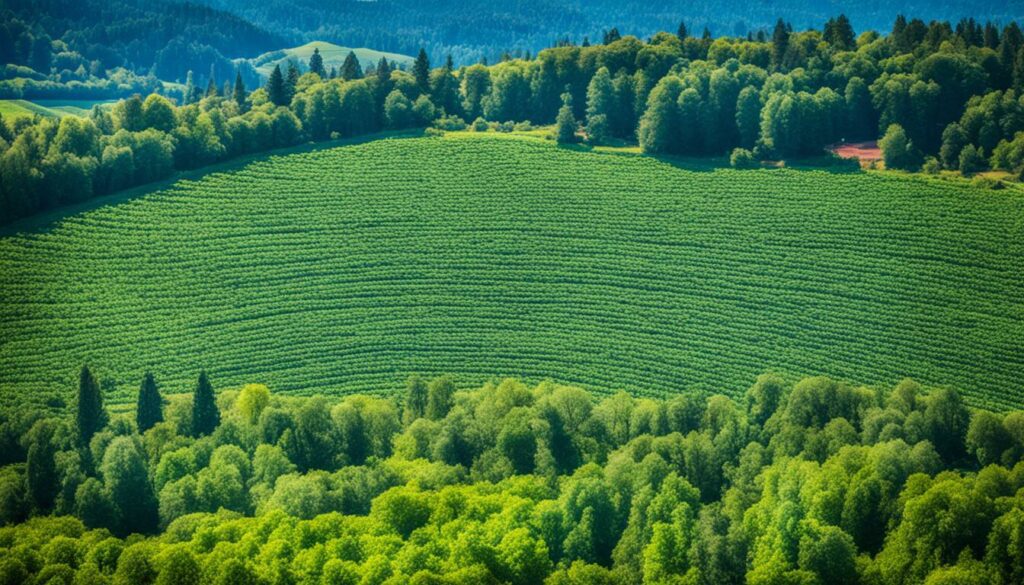
Agroforestry is great for bringing in more types of plants and animals. It can increase biodiversity by nearly 67%. This beats other ways like crop rotations hands down.
Cover crops are excellent in fighting off pests and diseases, offering a 125% boost. But intercropping and agroforestry aren’t far behind, offering about 66% and 59% more protection. These numbers show diversifying crops is a smart move.
Agroforestry also rocks when it’s about the soil. It improves soil quality by 19%, much higher than intercropping’s 11% boost. This is vital for keeping the soil healthy for planting.
Diversifying crops isn’t just good for plant and animal variety. It also makes farms tougher against climate change and economic shifts. Agroforestry boosts the soil’s carbon stores by 19% and helps store carbon long-term. This is big for fighting climate change.
Water regulation also gets a big lift with crop diversification, improving by 51%. This makes farms better at handling changes in markets or weather. These strategies make farms stronger, supporting both nature and the wallet.
“Agroforestry’s role in enhancing agricultural sustainability by promoting diversified farming systems is evident. The integration of diverse crops within these systems leads to a robust provision of ecosystem services, undeniably essential for both environmental and economic stability.” – Expert Analysis
| Criteria | Improvement Percentage |
|---|---|
| Associated Biodiversity | +66% (Agroforestry systems) |
| Soil Quality | +19% (Agroforestry systems) |
| Pest and Disease Control | +125% (Cover crop systems) |
| Soil Carbon Content | +19% (Agroforestry systems) |
| Water Regulation | +51% (Diversification strategies) |
Agroforestry creates different spaces that are great for wildlife. By studying many landscapes, we can see how each one helps or hinders plant and animal life. These landscapes include ones with more agriculture, more forests, or a mix of trees in different patterns.
Using agroforestry helps save different types of animals. This is very important because the world’s plants and animals are disappearing fast. Reasons include more people, changing diets, and cutting down forests. Soon, we’ll have 9.5 billion people. This, along with more farming and less trees, makes our planet less diverse.
Scientists use the Habitat Amount Hypothesis (HAH) to guess how many kinds of plants and animals are in a place. They link the type of landscape to what lives there. Agroforestry is great at keeping a lot of different plants and animals. It can even do better than regular forests in some cases.
Agroforestry lets farms be homes for many wild animals. This is good for wild animals and helps keep their homes safe. Half of Europe’s wildlife needs farmland to live in. So, agroforestry is key to keeping our environment balanced.
In Ethiopia, they studied how many different trees were in certain places. They found homegardens and the mix of trees and crops in parklands were good for nature. However, forests and grazing lands had even more types of trees. Ethiopia is losing some of its unique trees because farmers and leaders do not know how important they are. But, a farming style that mixes trees with crops clearly helps.
Trees, crops, and soil helpers work together in agroforestry. They boost soil regeneration. This relationship improves soil structure, helps with water and nutrient use, which is key for healthy agroecological systems.
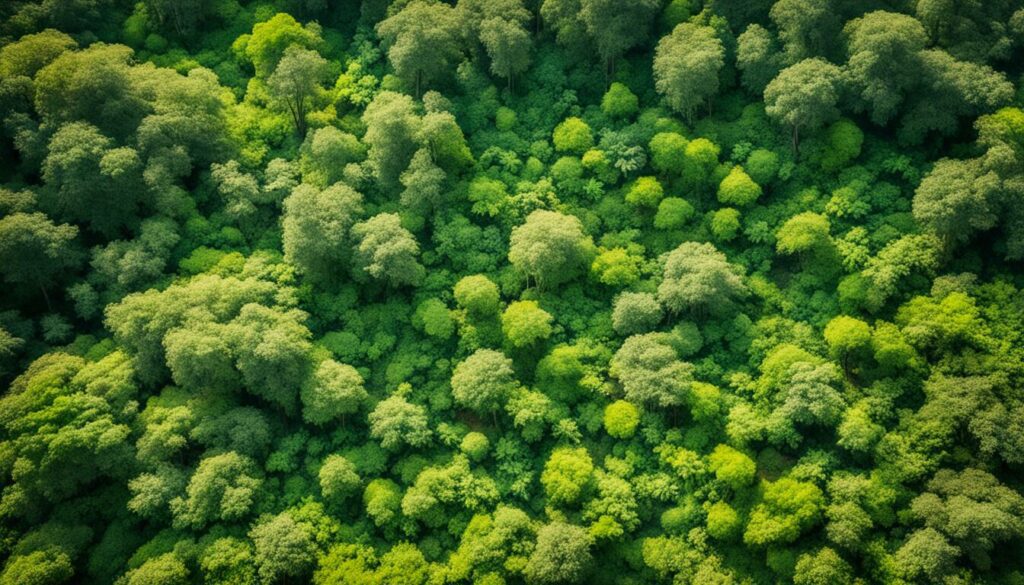
Research in 31 countries over 30 years adds a lot to what we know about agroecological systems health. There were 31,852 articles with 585 studies reviewed. Plants along borders and mixing trees with pastures stood out for their good impact on soil. This highlights agroforestry’s value in making ecosystems work better, making farms more productive, and solving waste problems.
Bad news in soil health: 73% of drylands’ pastures and 47% of not very rainy farmlands are in bad shape. A big part of watered farmlands is also worn out. More than 25% of the world’s soil is in a very bad state. Human activities cause most of this damage. This data shows we really need to focus on soil regeneration.
Agroforestry’s Impact on Soil Properties
Recent studies ask farmers what they think about soil health from planting trees with crops. 53% believe this method is the best for improving soil. Trees make more phosphorus and potassium available than just planting crops. This shows soil is better and agricultural systems are healthier when trees are part of the mix.
| Aspect | Traditional Agriculture | Agroforestry Systems |
|---|---|---|
| Soil Organic Carbon Loss | 60%-75% | Significantly Reduced |
| Nutrient Retention | Lower | Higher |
| Soil Structure | Degraded | Enhanced |
| Water Infiltration | Poor | Improved |
Agroforestry supports soil regeneration and keeps agroecological systems going. With more studies, it’s clear how important this method is for long-term environment health and growth.
Agroforestry is seen as vital for boosting biodiversity in farmlands. It involves planting trees alongside crops or animals. This method fights the loss of biodiversity and encourages farming variety. It creates ecosystems that are better at surviving and adapting.
Mixing trees and shrubs with farming introduces complex ecosystems. This setup closely resembles natural habitats. It offers more resources and shelter to different plant and animal species. This diversity helps farming produce more and makes the ecosystem stronger against harm.
Agroforestry makes farm habitats more varied, which attracts a wide range of species. The mix of plants and landscapes creates many different home environments. These places provide food, shelter, and breeding spots. It’s crucial for the survival of animals and plants that can’t live in regular farm settings.
Agroforestry benefits from having more types of species living in it. Studies show that these farming methods lead to a richer mix of plants and animals. In Europe, for example, half of all plant and animal species find a home in farm forests and fields. This proves agroforestry helps fight the loss of biodiversity, even while increasing farm productivity.
| Agroforestry Practices | Conservation Benefit | Example |
|---|---|---|
| Silvopasture | Increased species richness and density of breeding pairs | Higher bird diversity in wood pastures |
| Alley Cropping | Refuge for sensitive plant species | Butterfly diversity and abundance |
| Forest Farming | Habitat for diverse understory plant species | New spider species in Romanian faunas |
Agroforestry mixes farming with forest practices to help nature thrive. In places like Mediterranean Europe, you see trees mixed with pastures and orchards. This blend boosts both farming yields and the environment’s health.
It’s a key effort in fighting the loss of plant and animal species. This is very important in places like the Mediterranean. Here, many species have decreased a lot. Agroforestry makes environments more varied and interesting for different creatures. Recent studies and simulations show it helps save local wildlife.
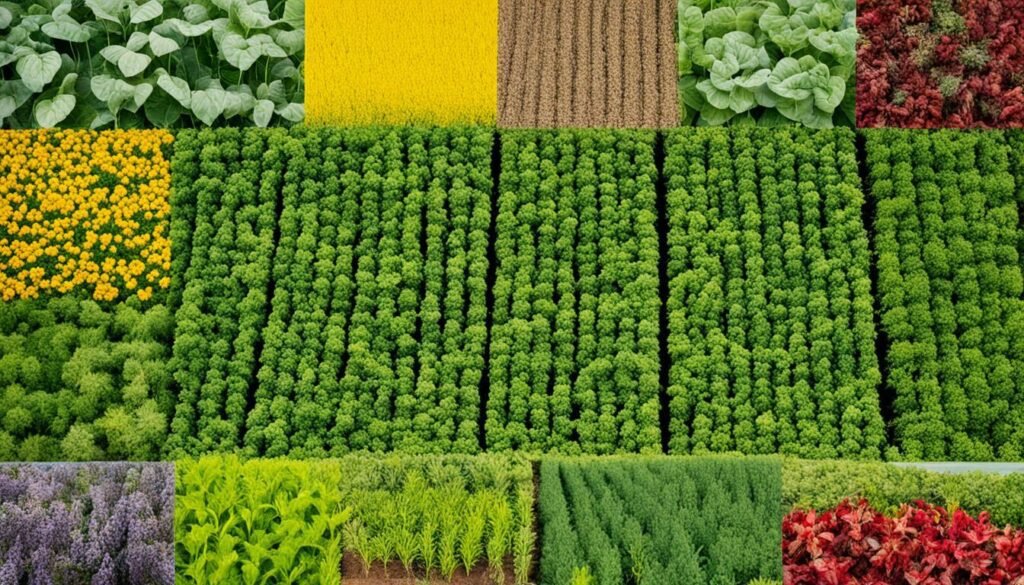
Many studies found good news about agroforestry. A big chunk showed that it helps more species live in an area, changes the type of species you see, and supports different kinds of ecological groups. In places like Brittany, a lot of farmers are putting up hedgerows. And most of them are using the wood from these hedges. This shows that many farmers care about wildlife.
The Habitat Amount Hypothesis (HAH) says that the more space there is for wildlife, the more species you’ll find. Agroforestry really works well with this idea. It makes farms into rich places for different types of life. This helps save species and plays a part in Europe’s plans to protect nature by 2030.
Integrating agroforestry boosts both farming and nature. By linking agricultural lands with wild spaces, it makes a better home for everything living there. This helps make our world a sustainable, living planet for the future.
Industrial agriculture focuses heavily on producing lots of food. This approach, however, harms our planet’s diverse life forms. It does this by creating simpler living spaces and using too many chemicals. Farmers often grow just one type of crop in a large area (monocultures). This choice, along with the use of many chemicals, damages the environment.
The shrinking of natural spaces happens when monocultures are grown. This change is bad for the many plants and animals that call these places home. Industrial agriculture favours a few high-yield crop types, not nature’s variety. This focus has seriously hurt populations, like monarch butterflies, reducing their numbers by 70 percent. This drop is mainly due to losing their homes.
The use of poisons and chemicals in farming is a big issue. These agrochemical impacts on ecosystems harm other plants and animals. For example, the herbicide glyphosate has cut down the types of wild plants in farming areas. Neonicotinoid pesticides hurt bees by limit their growth and muddle their messages. Pollution from farming is a major danger to many species around the world.
Facts are worrisome: from 2015, 2.5 million acres of meadow in the US became new farmland, causing a big loss in life’s variety. Not even forests are safe. Each year, more than 100,000 square miles of trees are disappearing forever. The Amazon, home to a quarter of all land species, is facing a critical condition because of these activities.
| Statistic | Impact |
|---|---|
| Species loss globally | 8.7 million estimated unique species under threat |
| Grassland conversion (US) | 2.5 million acres between 2015-2016 |
| Pollinator decline | 70% decline in populations such as monarchs |
| Deforestation | 100,000 square miles of forest lost annually |
| Agrochemical impacts | Reduction of wild plant diversity and harm to bees |
Agroforestry is a mix of old and new ways that fit each area’s nature and people. In Central America, coffee farms use trees to shade the plants. This helps the land keep its diversity and fights deforestation.
West Africa adds native trees to crop lands. This boosts the number of plants and animals and helps people find food and money. In Cameroon, cocoa fields now have fruit trees too. This change slows down turning forests into farms and helps the natural world.
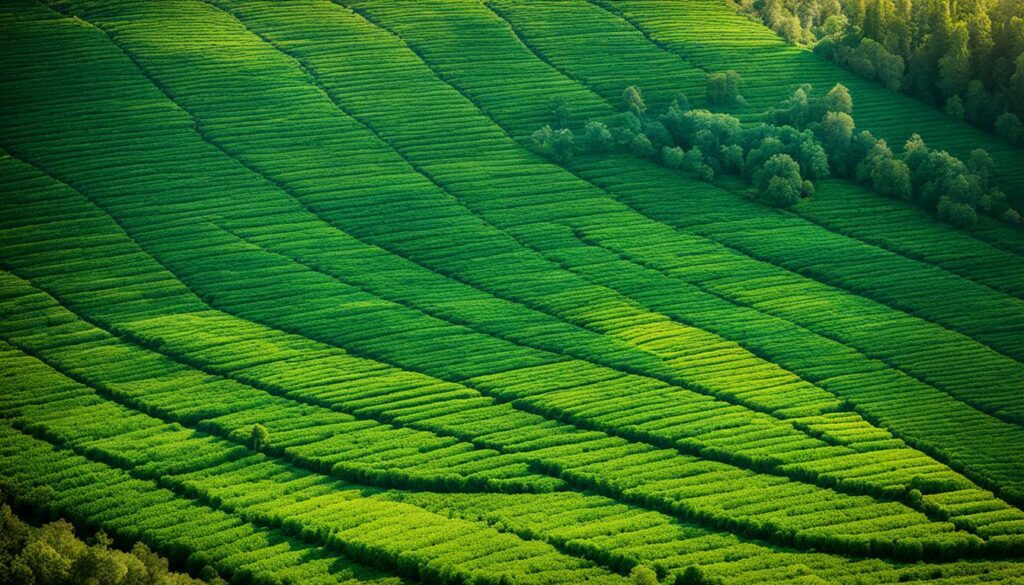
The United States is putting a lot into modern agroforestry. The government gave $60 million across many states to help. They work with top schools and groups to improve how we use trees in farming.
In Ecuador, farming mixes so well with nature that you see life everywhere. Agroforestry there shows how farming and the wild can live in harmony. In Malaysia, they are finding ways to grow a lot of oil palm without hurting the land. This is another step towards farming that’s good for nature and people.
Agroforestry joins farming and forests to tackle global nature problems together.
Both old and new ways of agroforestry are catching on worldwide. As more farmers and leaders choose these ways, the benefits for nature and people stand out more.
Here’s a look at how agroforestry helps in different places:
| Region | Agroforestry Practice | Benefit |
|---|---|---|
| Central America | Shade-grown coffee | Biodiversity enhancement |
| West Africa | Parkland systems | Nutrition and income |
| United States | Modern agroforestry | USDA fund, research collaboration |
| Cameroon | Fruit trees in cocoa plantations | Forest conservation |
| Ecuador | Biodiverse reserve | Rich ecosystem support |
This list shows how smart agroforestry use is natural everywhere. It’s key to looking after the land well all over the earth.
Many studies look into agroforestry and biodiversity. They offer great insights into how these systems help our environment. Through these studies, we understand more about the good sides of agroforestry for nature.
A big look at 28 studies found that in 22 of them, agroforestry was good for nature. This included more animals and plants, and different roles they play. But, 11 studies didn’t check this in the best way. Still, it showed agroforestry brings more types of life and more variety when compared to just farming.
In Europe, case studies also show that agroforestry is positive. For example, in Brittany, 20% of farmers now grow hedgerows. And 70% use the wood they get. This shows that planting trees with crops is good for the land and the people.
One study got a lot of attention, being looked at more than 5005 times. It showed that even young agroforestry, like planting trees between crops for only 8.5 years, can help nature a lot. These systems were good for many different kinds of animals and plants.
Lots of biodiversity studies support agroforestry. They say it’s a good idea to have trees with crops everywhere. The proof and ideas from these studies say we should use these systems more in farming today.
The Habitat Amount Hypothesis suggests that the number of species in a place is linked to how much of their preferred home is around. It’s key in agroforestry, mixing trees with crops to boost the different places living things can call home. Knowing this idea helps make agroforestry better, supporting a lively mix of plants and animals.
Agroforestry is vital for making landscapes that work in many ways, especially in places like the Mediterranean. Here, mixing trees with farming stops species from disappearing. By adding many homes for plants and animals, it uses the Habitat Amount Hypothesis to guess how diverse a space will be.
| Landscape Type | Impact on Biodiversity | Species Richness |
|---|---|---|
| Agroforestry | Enhanced habitat complexity | Higher |
| Intensive Agriculture | Habitat simplification | Lower |
| Forest | Stable ecosystems | Moderate |
| Linear Landscapes | Fragmented habitat types | Variable |
The Habitat Amount Hypothesis supports us in understanding nature’s balance, but it’s tricky in agroforestry. We need to get how the many habitats created interact. It’s also key to consider what different species need when planning agroforestry. Still, working with these landscape ideas can do a lot for balancing farming and protecting nature.
Agroforestry is a powerful way to protect the environment. It combines trees with farming or animals. This way, we can farm without harming nature. With many people reading about it and researchers supporting it, its influence is clear.
In Brittany, 20% of farmers are planting hedgerows. 70% of them are using the wood from these tree barriers. Also, many studies found positive effects on the environment, such as more diverse plants and animals. These show how agroforestry can make farming better for nature.
Studies show that agroforestry is better for wildlife than just forests or single tree farms. Techniques like alley cropping really help bring more species to the land. We need to use these methods more to protect the planet in the years to come.
Agroforestry boosts biodiversity by creating various ecosystems. It helps different species thrive. This practice improves soil and traps carbon in the ground.
It makes ecosystems stronger by keeping the soil healthy and stopping it from washing away. The land also holds onto important nutrients. This helps farms stay strong against tough situations.
Agroforestry makes farming better by mixing crops and trees. It uses natural ways to grow food. It also helps with things like helping plants grow and stopping pests.
It reduces the speed at which natural land is turned into farms. Agroforestry also connects pieces of land where different animals and plants can live. This is vital for keeping many types of life alive.
Yes, it does a lot to fight climate change. Agroforestry captures carbon in the soil and in plants. It helps lessen the damage of global warming.
Using many different crops makes the land healthier. These crops help the soil, encourage bees to pollinate, and keep pests away. The farm stays strong even when facing challenges.
By mixing trees and crops, it creates homes for all kinds of animals and insects. Farming and wild life can live together. This adds more life to the farm.
It renews the soil by making it better at holding water. This helps plants grow and stops nutrients from washing away. The soil becomes a great place for life to thrive.
Agroforestry makes farm lands more varied. This makes homes for many plants and animals. The different habitats help life on the farm stay strong in changing environments.
Integrating trees with crops, using cover crops, and growing several crops together help. These methods make farming and natural lands work well together. They make more room for life.
Intense farming, like having only one type of crop, does not support many kinds of life. It damages the soil and water. Agroforestry is a better way to farm without hurting nature.
Agroforestry looks different in various parts of the world. Shade-grown coffee in Central America and region-Ss in West Africa are good examples. They show how agroforestry fits each place’s needs and traditions.
Studies show agroforestry really helps keep a wide range of life. They say it does this by offering different homes and supporting many services the ecosystem needs.
The Habitat Amount Hypothesis talks about how much different homes matter to life. Agroforestry fits this idea by creating many different habitats in farms. It helps more kinds of plants and animals live there.